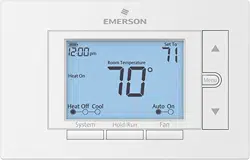Documents: Go to download!
- Owner's manual - (English)
- 1. PREPARATIONS
- 2. THERMOSTAT DETAILS
- 3. REMOVING OLD THERMOSTAT
- 4. MOUNTING AND WIRING YOUR NEW THERMOSTAT
- 5. CHECK THERMOSTAT OPERATION
- 6. USING YOUR THERMOSTAT
- 7. SPECIFICATIONS
- 8. TROUBLESHOOTING
Table of contents
User manual Thermostat
1. PREPARATIONS
Precautions
- Do not exceed the specification ratings.
- All wiring must conform to local and national electrical codes and ordinances.
1.1 Check package contents
This package should contain the following items:
- Thermostat
- Mounting screws and wall anchors (x2)
- 2 AA batteries
- Terminal wire label stickers
- Installation instructions
1.2 Gather tools
Required tools:
- Small Phillips or Flat-head screwdriver
- Small pliers (needle-nose)
- Drill with 3/16” (4 mm) bit
Optional tools:
- Wire cutters/stripper
- Hammer (for wall anchors)
2. THERMOSTAT DETAILS
The thermostat buttons and switches
- Fan button
- Hold a permanent temperature, or release the hold to return to the programmed schedule
- System button
- Backlight button
- Raises temperature setting
- Access menu options
- Lowers temperature setting
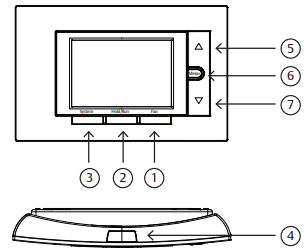
The display
- Next (Menu button) is used to navigate within a menu
- Set the correct time, access the schedule and customize thermostat settings.
- Back (Fan button) is used to navigate within a menu
- Exit (Hold/Run button) returns to the home screen
- Thermostat is protecting the equipment from short cycling (5-minute delay)
- Indicates that the system is running in Cool, Heat or Auxiliary mode. (Heat Pump Only -The auxiliary will run in Heat mode when the heat pump cannot maintain the set temperature.)
- SEE TROUBLESHOOTING
- Battery status indicator
- Replace battery indicator
- Day of the week used when programming a schedule
- Permanent hold (bypassing the schedule)
- Temperature setpoint
- Appears when the keypad is locked (to prevent unwanted changes)
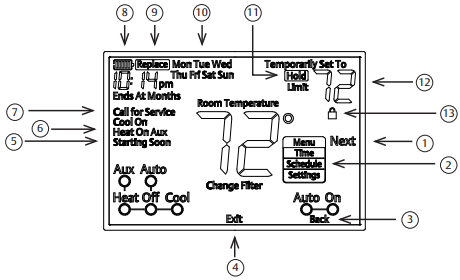
3. REMOVING OLD THERMOSTAT
3.1 Turn off power
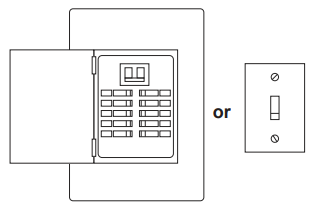
To ensure the power to your heating and cooling system has been turned off, try to turn on heating or cooling by changing the temperature on your old thermostat.
3.2 Remove the old thermostat cover
Remove the old thermostat’s front cover from the wall base. Some covers pull off easily, while others may need to be released by using a screwdriver.
3.3 Label wires
Tip: Taking a picture with a camera or smartphone can help you not only remember how wires are connected to the terminals, but can also ensure that you label your wires correctly. Mislabeling the wires may result in a high energy bill or damage to your heating and cooling system.
For each wire that comes out of wall, follow these 4 steps.
Note that this step is very important for configuring your system in section 4.5. Please follow instruction carefully.
- Locate the terminal letter that the wire is connected to in the first column of the table
- Write down the old thermostat terminal letter in the second column.
- Label that wire with the corresponding letter in the third column.
- Disconnect the labeled wire carefully, and proceed to the next wire until all wires are labeled.
Please note that not all terminals may be used and that there’s no standard color code for thermostat wires, so your wire colors may vary. For your reference, we’ve included a terminal label reference chart below to help you connect the wires from your old thermostat to your new thermostat in case you get stuck.
Terminal labeling reference chart
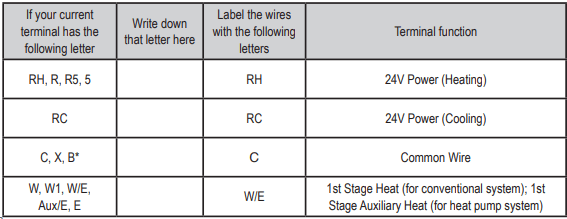
Terminal labeling reference chart, contʼd.

Do you have a “B” wire?
Labeling the “B” wire can be tricky. It could be labeled as “C” or “O/B” depending on whether you have an “O” wire connected to your old thermostat. Please pay attention and follow the asterisk (*) comments below while labeling.
* Label “B” as “C” only if the old thermostat also had a wire in the “O” terminal block. If there was no wire in the “O” terminal block, label the wire as “O/B”
** On heat pump systems with separate W2 and E wires, label both wires W/E (2 wires on one terminal)
3.4 Identify jumper wire
For terminal RC and RH:
| On your old thermostat, if… | Then, on your new thermostat… |
| Terminal RC and RH are connected with a jumper wire | Leave the RC/RH jumper wire in its place |
| There’s only one R wire (RC, RH, R or R5) coming out of the wall | Leave the RC/RH jumper wire in its place |
| Two separate R wires come out of the wall, and they are NOT connected by a jumper wire | Clip the jumper wire between RC and RH on the back of the new thermostat |
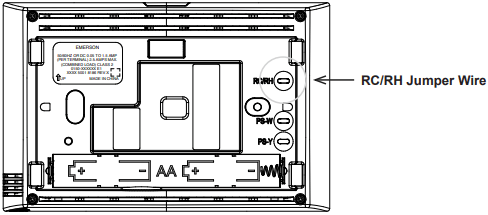
3.5 Remove old thermostat base
With all of your wires disconnected and properly labeled, you may now safely remove the thermostat base from your wall.

Tip: Worried about having your wires falling into your wall? Keep the wires secure by wrapping the them around a pencil.
4. MOUNTING AND WIRING YOUR NEW THERMOSTAT
4.1 Install new thermostat base
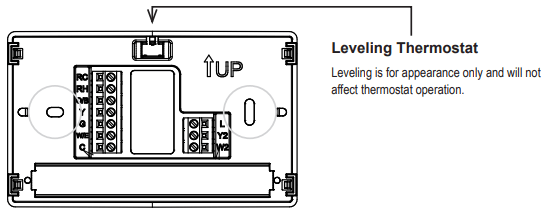
Mount your new thermostat base using the supplied screws. Drill holes and insert wall anchors to secure the thermostat base to the wall, if necessary.
4.2 Connect wires to corresponding terminal blocks
Match each labeled wire to it’s corresponding terminal on the mounted thermostat base. Insert each labeled wire into the hole of it’s matching terminal, and using the screwdriver, tighten the screw on the terminal block securely.
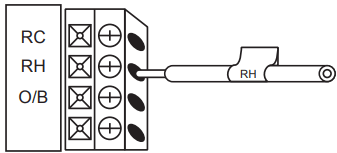
4.3 Identify system configuration
Your wiring can help to determine the type of heating and cooling equipment installed in your home. Before attaching the front cover, use the following chart, and check the box next to the settings that match your new thermostat’s wiring. This information will be used in Step 4.5 to configure your thermostat.
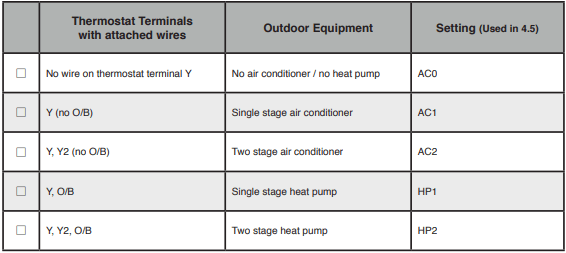
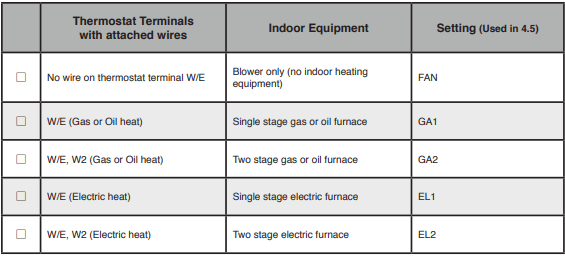
4.4 Install the batteries and attach front cover
Install the included AA alkaline batteries and push the front cover on to the thermostat base until it’s secure.
4.5 Configure thermostat
Hold the menu button down for 8 seconds to launch the installer menu. Your screen will change to the configuration menu. Set the first 3 items (05, 10, 15) to match your equipment. Please refer to the table in Section 4.3 and Section 3.3 to find out your equipment type and previous wiring configuration.

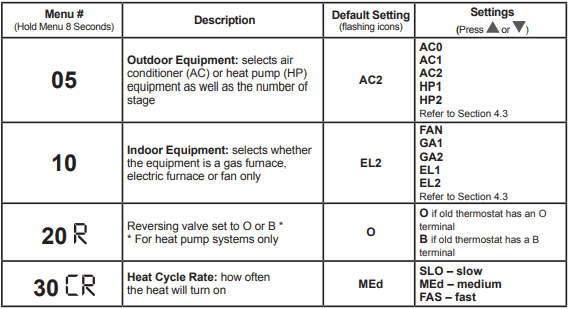
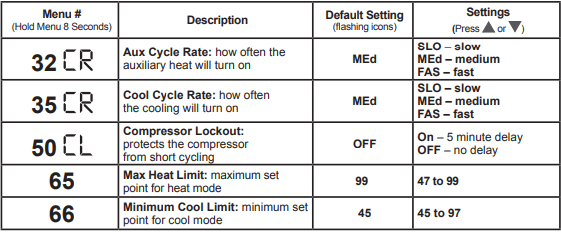
* Setting the reversing valve to “O” or “B” is necessary for heat pump systems only. Please refer to the chart in section 3.3 for your old thermostat’s wiring.
On your OLD thermostat
• if you had a wire connected to “O” terminal, set reversing valve (menu # 20) valve as “O” at this step.
• if you had a wire connected to “B” terminal (and at the same time, no wire was connected to “O”), set reversing valve as “B” at this step
• if you had a wire connected to “O/B” terminal, please call Customer Support at 877.654.9394.
4.6 Turn on power
Turn on your power at the source.
Congratulations! You’ve completed the thermostat installation process.
5. CHECK THERMOSTAT OPERATION
5.1 Fan operation
If your system does not have a G terminal connection, skip to 5.2 Heating system.
- Press the fan button to select the ON position. The blower should begin to operate.
- Press the fan button to select the AUTO position. The blower should stop immediately
5.2 Heating system
1. Press the System button to select the Heat position.
2. Press  to adjust thermostat setting to 1° above room temperature. The heating system should begin to operate and the thermostat will indicate Heat On.
to adjust thermostat setting to 1° above room temperature. The heating system should begin to operate and the thermostat will indicate Heat On.
3. For heat pump with auxiliary- Press  to adjust thermostat setting to 3° above room temperature. The auxiliary heat should begin to operate and the thermostat will indicate Heat On Auxiliary.
to adjust thermostat setting to 3° above room temperature. The auxiliary heat should begin to operate and the thermostat will indicate Heat On Auxiliary.
4. Press  to adjust thermostat setting below room temperature. The heating system should stop operating and the Heat On icon will disappear.
to adjust thermostat setting below room temperature. The heating system should stop operating and the Heat On icon will disappear.
5.3 Auxiliary only mode (heat pump systems)
1. Press the system button to select the Aux position. This bypasses the heat pump and runs auxiliary heat only.
2. Press  to adjust thermostat setting to above room temperature. The auxiliary heating system should begin to operate and the thermostat will indicate Heat On Aux.
to adjust thermostat setting to above room temperature. The auxiliary heating system should begin to operate and the thermostat will indicate Heat On Aux.
3. Press  to adjust thermostat setting below room temperature. The auxiliary heating system should stop operating and the Heat On Aux icon will disappear.
to adjust thermostat setting below room temperature. The auxiliary heating system should stop operating and the Heat On Aux icon will disappear.
5.4 Cooling system
1. Press the system button to select the Cool position.
2. Press  to adjust thermostat setting 1° below room temperature. The blower should come on immediately on high speed, followed by cold air circulation. The thermostat will indicate Cool On. There can be up to a 5 minute delay. (see INSTALLER MENU, item 50)
to adjust thermostat setting 1° below room temperature. The blower should come on immediately on high speed, followed by cold air circulation. The thermostat will indicate Cool On. There can be up to a 5 minute delay. (see INSTALLER MENU, item 50)
3. Press  to adjust thermostat setting to 1° above room temperature. The cooling system should stop operating and the Cool On icon will disappear.
to adjust thermostat setting to 1° above room temperature. The cooling system should stop operating and the Cool On icon will disappear.
6. USING YOUR THERMOSTAT
6.1 User menu
To customize thermostat settings, press the Menu button from the home screen. Use the  or
or  buttons to highlight Settings and press Next. Use Next and Back to navigate through menu items. Press
buttons to highlight Settings and press Next. Use Next and Back to navigate through menu items. Press  or
or  to change the setting.
to change the setting.
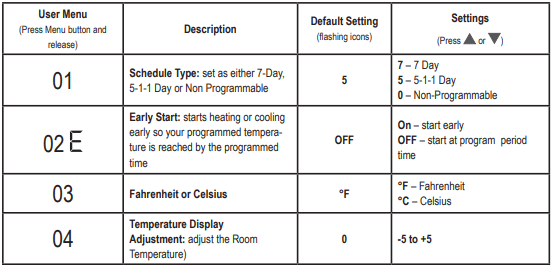
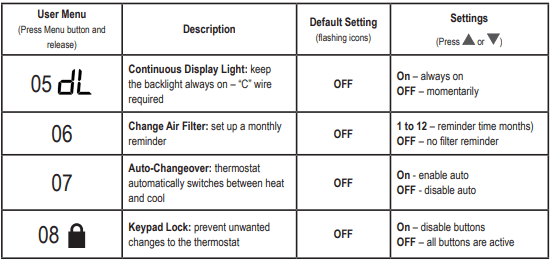
6.2 Thermostat operation
Set Current Time and Day
Note: Time icons will flash at initial power up or after a reset.
- Press Menu
- The time icon will be flashing, Press Next to advance and set the time
- Use
 or
or  to set the correct time
to set the correct time - Press Next and use
 or
or  to set the correct day
to set the correct day - Press Exit when finished.
The default program is 5-1-1 Day, but can be setup as a 7-Day or Non-Programmable thermostat (refer to the User Menu on pages 25-26)
- Hold Temperature (bypassing the schedule) – With the System set to Heat or Cool, momentarily press the Hold/Run button. Hold will be displayed. Use
 or
or  to adjust the temperature. The thermostat will hold the room temperature at the selected setting until you press Hold/Run again to start program operation (cancels permanent Hold)
to adjust the temperature. The thermostat will hold the room temperature at the selected setting until you press Hold/Run again to start program operation (cancels permanent Hold) - Program Override (Temporary Hold) – Press
 or
or  until the desired temperature is displayed. The thermostat will override the schedule until the next programmed time period with a minimum override of 2 hours. Then the thermostat will automatically revert to the program.
until the desired temperature is displayed. The thermostat will override the schedule until the next programmed time period with a minimum override of 2 hours. Then the thermostat will automatically revert to the program. - Keypad Lockout – To prevent unwanted changes, the buttons can be disabled. To turn this feature On, press and hold
 and the Menu button until the
and the Menu button until the  icon appears (this can also be turned on in the menu). To turn Off, press and hold
icon appears (this can also be turned on in the menu). To turn Off, press and hold  and the Menu button for 3 seconds.
and the Menu button for 3 seconds.
6.3 Thermostat schedule
Energy Saving Factory Schedule
This thermostat is programmed with the energy saving settings shown in the table below for all days of the week.

Note: Thermostat can be programmed on or off the subbase
Modify the Heating Schedule
- Use the System button to select Heat
- Press Menu
- Use the button to select Schedule and press Next to enter the schedule
- The time icons will flash – use or to set the time for the start of a period
- Press Next – the set point icons will flash – use or to set the temperature for the current period
- Continue to press Next to advance through all periods (Wake, Leave, Return, Sleep) for all days of the week.
Note: Press Back to return to the previous setting. Once all days of the week have been programmed the thermostat will display End. Press Exit at any time to save changes and return to home screen.
Modify the Cooling Schedule
- Use the System button to select Cool
- Repeat steps 2-6 from the heating schedule
7. SPECIFICATIONS
Electrical Rating:
Battery Power..................................... mV to 30 VAC, NEC Class II, 50/60 Hz or DC
Input-Hardwire.................................... 20 to 30 VAC, NEC Class II, 50/60 Hz
Terminal Load..................................... 1.5 A per terminal, 2.5A maximum all terminals combined
Setpoint Range................................... 45° to 99° F (7° to 37° C)
Rated Differentials (@ 6°F/ Hr): ......... Fast Med Slow
Heat (Conventional Gas / Oil / Elect).. 0.5°F 0.75°F 1.9°F
Cool (Central Air)................................ 0.9°F 1.2°F 1.7°F
Heat Pump (Heat and Cool) ............... 0.9°F 1.2°F 1.7°F
Heat Pump Aux................................... 0.5°F 0.75°F 1.9°F
Operating Ambient.............................. 32°F to +105°F (0° to +41°C)
Display Temperature Range............... 32°F to +99°F (0 to 37°C)
Operating Humidity............................. 90% non-condensing maximum
Shipping Temperature Range............. -20°F to + 150°F (-29° to +65°C)
Thermostat Dimensions...................... 3-3/4” H x 6” W x 1-1/8” D
8. TROUBLESHOOTING
| Symptom | Possible Cause | Corrective Action |
| No Heat/No Cool/No Fan (common problem) |
1. Blown fuse or tripped circuit breaker 2. Furnace power switch to OFF 3. Furnace blower compartment door or panel loose or not properly installed 4. Loose connection to thermostat or system |
1. Replace fuse or reset breaker. 2. Turn switch to ON. 3. Replace door panel in proper position to engage safety interlock or door switch. 4. Tighten connections |
| No Heat |
1. System not set to Heat 2. Loose connection to thermostat or system 3. Heating System requires service or thermostat requires replacement |
1. Set thermostat to Heat. 2. Verify thermostat and system wires are securely attached. 3. Diagnostic: Set System to Heat and raise the setpoint above room temperature. Within five minutes the thermostat should make a soft click sound and “Heat On” should appear on display. This sound indicates the thermostat is operating properly.If the thermostat does not click, try the reset operation listed below. If the thermostat does not click after being reset, contact your heating and cooling service person or place of purchase for a replacement. If the thermostat clicks, contact the furnace manufacturer or a service person to verify the heating system is operating correctly. |
| No Cool |
1. System not set to Cool 2. Loose connection to thermostat or system 3. Cooling System requires service or thermostat requires replacement |
1. Set thermostat to Cool. 2. Verify thermostat and system wires are securely attached. 3. Diagnostic: Set System to Cool and lower setpoint below room temperature. Same procedures as diagnostic for “No Heat” condition except set the thermostat to Cool and lower the setpoint below the room temperature. There may be up to a five minute delay before the thermostat clicks in Cooling if the compressor lock-out option is selected in the installer menu. (see INSTALLER MENU, item 50) |
| Heat, Cool or Fan Runs Constantly. | Possible short in wiring, thermostat, heat, cool or fan system | Check each wire connection to verify they are not shorted or touching other wires. Try resetting the thermostat. If the condition persists contact your HVAC service person. |
| Thermostat Display & Thermometer Disagree | The location of the thermostat and/or the size of the Heating System may be influencing the cycle rate |
Display can be adjusted +/-5°. See User Menu item 05 |
| Furnace (Air Conditioner) Cycles Too Fast or Slow (narrow or wide temperature swing) | The location of the thermostat and/or the size of the Heating System may be influencing the cycle rate | Digital thermostats provide precise control and cycle faster than older mechanical models. The system turns on and off more frequently, but runs for a shorter time. If you would like to increase cycle time, choose SLO for slow cycle in the Installer menu. (Reference menu items 30, 32 & 35) If an acceptable cycle rate is not achieved, contact your HVAC service person. |
| “Call for Service” icon appears on displayed |
1. Heating system is not able to heat the space to within 10 degrees of the setpoint within 2 hours 2. Cooling system is not able to cool the space to within 10 degrees of the setpoint within 2 hours 3. If “--” is displayed for the Room Temperature, a replacement thermostat is needed 4. None of the buttons operate on the thermostat 5. If “Call for Service” is flashing, compressor self diagnostic is detecting an issue with the outdoor unit |
1. See corrective action for “No Heat” 2. See corrective action for “No Cool” 3. Replace thermostat 4. Make sure keypad lockout is not turned on ( 5. Contact a service person to verify the outdoor equipment is operating correctly |
| Heat pump system runs heat in cool mode/cool in heat mode | Changeover “O/B” set incorrectly | Use configuration to switch “O” to “B” or “B” to “O" |
Resetting the Thermostat or Thermostat Settings
If the thermostat has good batteries, but has a blank display or does not respond to key presses, the thermostat should be reset by removing the batteries for 2 minutes. This reset will not change the menu settings or program. If the condition persists after reinstalling the batteries, replace the thermostat.
To conveniently reset only the schedule and user settings back to factory defaults, press Menu and Backlight buttons at the same time and hold until the display goes blank and resets.
See other models: 1F83H-21PR WS1200VA ER108002 EAD50SE1 ST75
